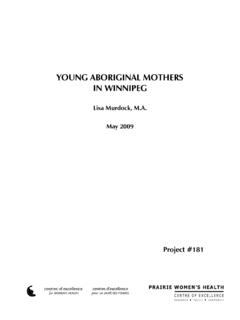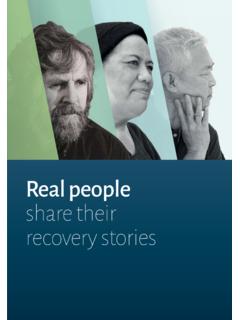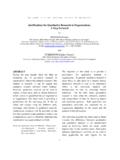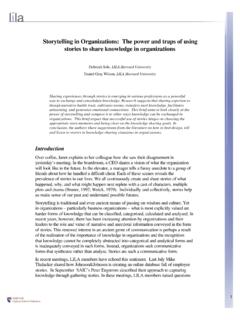Transcription of A PRACTICAL GUIDE TO PHOTOVOICE: SHARING PICTURES, …
1 A PRACTICAL GUIDE TO photovoice : SHARING PICTURES, TELLING stories AND CHANGING COMMUNITIES Beverly Palibroda with Brigette Krieg, Lisa Murdock and Joanne Havelock March 2009 Front Cover Photo: Without a world, there are no Without friends, you have no A PRACTICAL GUIDE TO photovoice : SHARING PICTURES, TELLING stories AND CHANGING COMMUNITIES Beverly Palibroda with Brigette Krieg, Lisa Murdock and Joanne Havelock March 2009 Prairie Women s Health Centre of Excellence (PWHCE) is one of the Centres of Excellence for Women s Health, funded by the Women s Health Contribution Program of Health Canada. The PWHCE supports new knowledge and research on women s health issues; and provides policy advice, analysis and informa-tion to governments, health organizations and non-governmental organizations. The views expressed herein do not necessarily represent the official policy of the PWHCE or Health Canada.
2 The Prairie Women s Health Centre of Excellence 56 The Promenade Winnipeg, Manitoba R3B 3H9 Telephone (204) 982-6630 Fax (204) 982-6637 This is project #157 of the Prairie Women s Health Centre of Ex-cellence. ISBN: 978-1-897250-19-8 Exposed Broken Old Tree Lisa Aymont-Hunter 2005 I know money isn t the most important thing, but I know it is the root cause for a lot of dis-ease, dis-harmony, and social problems. I m not a mathematician, but come on! Don t wait until we are sick, and scared and alone. i ACKNOWLEDGEMENTS In recent years, Prairie Women s Health Centre of Excellence (PWHCE) led five photovoice research projects in communities across the prairie region of Canada. Researchers and community members worked together to gain the first-hand experience and knowledge about photovoice that is reflected in this manual.
3 We want to offer our appreciation to all those who were involved. PWHCE is especially grateful for the contributions made by the courageous prairie women who offered a part of themselves through personal stories and photographs. The women generously dedicated time, hard work and their unique perspectives that made each photovoice project one of a kind. These gifts will not be forgotten. We would also like to thank and honour: Kay Willson for her coordi-nation of the Saskatoon project; Rachel Rapaport Beck for coordina-tion of the Winnipeg project; Stacey Guy for originating and Diane Martz and Joanne Havelock for coordination of the Regina projects, as well as April Buffalo-Robe and Stacey Mustatia for their work as facilitators; Brigette Krieg for her work coordinating photovoice in Prince Albert. The assistance of Kay Willson and Linda Snyder in reviewing the draft of the manual is also appreciated.
4 You have all shown that by working together, the goals of photovoice can be achieved and many lessons can be learned. Caroline Wang and her colleagues, the researchers recognized for developing photovoice , have also earned our deep appreciation. The early photovoice research continues to inspire community groups and researchers throughout the world to use photovoice as a tool of empowerment and social change. PWHCE receives financial support from the Women s Health Con-tribution Program, of the Bureau of Women s Health and Gender Analysis, Health Canada. This allowed PWHCE to support our own photovoice projects and to develop this manual. The projects took place in different communities allowing us to develop a broad un-derstanding of photovoice and greater confidence to pursue the crea-tion of a manual. Without financial support each step of the way we could not have done this work.
5 Ii FOREWORD photovoice is a ground-breaking approach to participatory action research. In recent years, PWHCE has learned a great deal about photovoice . We have learned about the theory and research meth-ods of photovoice and we have learned how to work with community groups to carry out photovoice projects in practice. We have learned that, through photovoice , marginalized community members are empowered to share their words and photographs as a way to reach decision-makers and implement positive change in their home com-munities. We have learned that marginalized individuals, commu-nity workers and advocates, community groups and researchers alike are interested and eager to learn more about photovoice as a creative tool for health promotion and social change. Indeed, we are enthusiastic about our photovoice journey and want to share what we have learned with others who are interested in community-based research.
6 For this reason, we have created this manual as an invitation to you, the reader, to join us in our journey of discovery. Through this manual we intend to provide diverse groups of individuals with the tools necessary to engage in photo-voice. Whether you are a community member, advocate, possible photo-voice participant, student or researcher, this manual has something to offer. It promises to: increase understanding of photovoice by providing a clear definition and explanation of the research method; offer PRACTICAL guidance and a step-by-step process for using photovoice ; and Motivate others by SHARING compelling stories , photographs and case studies of actual photovoice projects. We have designed this manual to include: sections to easily find information; a glossary of terms for quick reference; iii text boxes to highlight key points and lessons learned from our experiences; PRACTICAL tips and things to consider when conducting your own photovoice project; a checklist to help with the planning and organization of your own photovoice project; and suggested resources for further learning.
7 The beauty of photovoice is its diversity; every photovoice project is different, and each project has a different focus. With photovoice , different stories are told, different photographs are captured and different outcomes are sought. Despite the many differences, com-mon to each photovoice project is its effectiveness as a method to re-veal real life experiences and empower marginalized individuals. As such, PWHCE has enabled girls and women to use photovoice to represent their health-related needs and interests. The selected case studies included in this manual represent our ex-periences; the information presented is meant to inform and spark interest in community-based photovoice projects. Before you begin your own unique photovoice journey, we want you to understand that your photovoice experience will be your own. It is our hope that the SHARING of this information with a broad spectrum of readers will result in diverse projects that give voice to marginalized mem-bers of our communities.
8 We wish you the best of luck on your photovoice journey. iv CONTENTS ACKNOWLEDGEMENTS FOREWORD PART ONE Glossary of Terms ..4 PART TWO What is photovoice ?..8 Key Concepts of When to use photovoice in Community Research ..12 Advantages and Limitations of photovoice and Women s Health PWHCE Selected PART THREE Steps in the photovoice Step One: Connecting and Consulting with the Step Two: Planning a photovoice Step Three: Recruiting Participants and Target Audience Step Four: Beginning the photovoice Project ..39 Step Five: photovoice Group Step Six: Data Collection ..52 Step Seven: Data Step Eight: Preparing and SHARING the photovoice Step Nine: Social Action and Policy PART FOUR photovoice APPENDIX Background Information ..71 References and Additional A PRACTICAL GUIDE to photovoice Prairie Women s Health Centre of Excellence 1 PART ONE Bad Weather Elaine Gamble, 2006 This is a picture of me driving out to my reserve to try to get financial aid because my power and my rent was due.
9 My husband lost his job and we re having a really hard financial time. I had to take my kids on the highway in this kind of weather because if I didn t, my power was going to get cut off and I wasn t going to have a place to live with my chil-dren. It was a gamble to go out because I wasn t guaranteed anything, and, in fact, I didn t receive anything. A PRACTICAL GUIDE to photovoice Prairie Women s Health Centre of Excellence 2 INTRODUCTION Prairie Women s Health Centre of Excellence (PWHCE) is an organization dedicated to improving the health status of Canadian women. With offices in Manitoba and Saskatchewan, PWHCE represents a large geographic area and a diverse cross-section of women.
10 Federal funding from the Women s Health Contribution Program, through the Bureau of Women s Health and Gender Analysis of Health Canada supports the research carried out by PWHCE. As one of the Centres of Excellence for Women s Health, PWHCE has a long history of collaborative work with community members and developing partnerships with academic facilities and various levels of government. Rigorous community-based research into the social and other determinants of women s health has allowed PWHCE to develop a level of expertise in policy-oriented and com-munity-based research and analysis on women s health. With this expertise, PWHCE is in a position to advise on policy changes that may make the health and social systems more effective in improving the health and lives of women and girls. Currently, PWHCE focuses attention to four broad program areas, including: Women and poverty; Aboriginal women s health; Rural, remote and northern women s health; and Gender and health planning Through our extensive collaboration and SHARING of research results in these four program areas, PWHCE has assisted in expanding our understanding of women s health issues on a local, regional, national and even international level.









